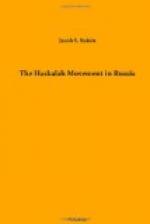“Back to the soil!” Was not this the cry of the romantic Maskilim in Germany, in Galicia, and particularly in Russia? And have not country life and field labor been depicted by them in the most glowing colors? Here was an opportunity to save the honor of the Jewish name and also ameliorate the material condition of the Russian Jews. The permission given to them by Alexander I to establish themselves as farmers in the frigid yet free Siberian steppes was greeted with enthusiasm by all. Nicholas’s ukase was hailed with joy. Elias Mitauer and Meyer Mendelssohn, at the head of seventy families from Courland, were the first to migrate to the new region (1836), and they were followed by hundreds more. Indeed, the exodus assumed such proportions that the Christians in the parts of the country abandoned by the colonists complained of the decline in business and the depreciation of property. The movement was heartily approved by the rabbis; the populace, its imagination stimulated, began to dream dreams and see visions of brighter days, and all gave vent to their hopefulness in songs of gladness and gratitude, in strains like these:[37]
Who lives so free
As the farmer on his land?
His farm his companion is,
His never-failing friend.
His sleep to him is sweet
After a hearty meal;
Neither grief nor worry
The farmer-man doth feel.
He rises very early
To start betimes his toil,
Healthy and very happy
On his ever-smiling soil.
O blessings on our czar,
Czar Nikolai, then be,
Who granted us this gladness,
And bade the Jews be free.
Alas, this joy was of short duration! Very soon Nicholas became suspicious of his Siberian colonization scheme, that it was in reality a philanthropic measure, and in place of saving the Jew’s soul it only promoted his physical well-being. This suspicion grew into a conviction when he learned that the Jewish community at Tomsk, still faithful to the heritage of Israel, applied for permission to appoint a spiritual leader. The autocrat, therefore, signed an ukase checking settlement in the hitherto free land, depriving honest men of the privilege enjoyed by the worst of criminals, and enrolling the children of those already there among the military Cantonists (January 5, 1837).
Then began real misery. Believing at first that the czar’s intentions were sincere, many Jews had sold their hut and land and left for Siberia. No sooner were they there than they were sent, on foot, to Kherson. The decree of the “little father” was executed in—no other phrase can describe it so well—Russian fashion. The innocent Jews who had come to Siberia by invitation were seized, treated as vagabonds, and deported to their destination. Want and suffering produced contagious diseases, and many became a burden to the Jews of Kremenchug and such Christians as could not witness unmoved the infernal comedy played by the defender of the Greek Catholic Church. Help could be rendered only secretly, and those who dared complain were severely punished.




